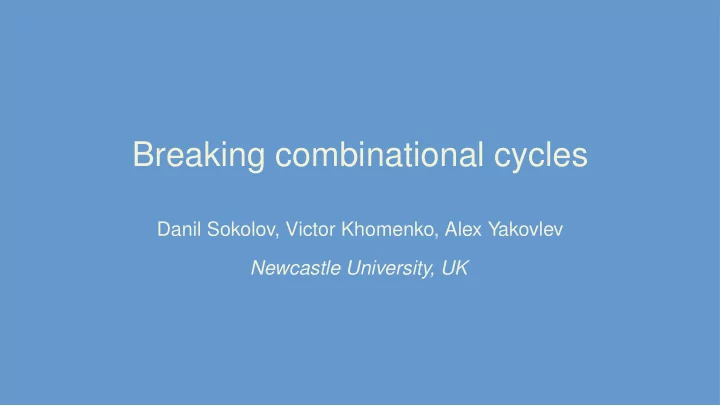

Breaking combinational cycles Danil Sokolov, Victor Khomenko, Alex Yakovlev Newcastle University, UK
Introduction Combinational cycles • Common in asynchronous circuits (implement “memory”) • ... but they upset conventional EDA tools • Static timing analysis (e.g. S YNOPSYS P RIME T IME ) • Eliminates cycles by disabling some timing arcs • Unpredictable and suboptimal choice of timing arcs to disable • May remove important timing paths, e.g. critical paths • ATPG and offline testing (e.g. S YNOPSYS T ETRA MAX) • Limited controlability of signals in the combinational cycles • i.e. inability to set signal to a specific state via primary inputs Need for design automation • 2 / 12
Cycle breaking in W ORKCRAFT Path breaker property • Boolean flag, unset (False) by default • Associated with input and output pins of circuit components • Used to break combinational cycles • Input pin whose Path breaker property is set (True) • Generates set_disable_timing constraint to disable the timing arcs from the input pin • These constraints can be dumped to an SDC file for use with conventional EDA tools • Not always possible to break all cycles while preserving important timing paths • Output pin whose Path breaker property is set (True) • Inserts specially implemented testable buffer and testable inverters after the output pin • Testable elements are designed to break cycles without removing timing paths • SCAN-enabled testable elements for compatibility with conventional DfT [1] • [1] D. Lloyd, R. Illman: “Scan insertion and ATPG for C-gate based asynchronous designs”, SNUG, 2014. 3 / 12
Cycle analyser tool Highlighting of gates and pins • Toggle Path breaker (PB) property • Pin click – toggle PB of the pin • Gate click – toggle PB of gate output pin • Automatic loop breaking • Insertion of testable buffers/inverters • Insertion of SCAN chain • Writing set_disable_timing constraints • 4 / 12
Disabling timing arcs Demo: celement-aoi222.circuit.work • OUT_BUBBLE1.I – bad path breaker as removes input-output paths (P RIME T IME choice) • U2.A and U2.F – good pair of path breakers (under assumption that feedbacks are fast) • Write SDC... button for dumping set_disable_timing constraints: • set_disable_timing U2 -from A2 -to ON set_disable_timing U2 -from C2 -to ON 5 / 12
Disabling timing arcs: Not always possible Demo: celement-decomposed.circuit.work • Needs g3.B or g4.A as path breaker, but both are on critical paths: • Rise phase: in1+, g1+, in2+, g0-, g3+, [via g4.A] g4-, g0+, out+ • Fall phase: in1-, in2-, g1-, g4+, [via g3.B] g3-, out- • 6 / 12
Insertion of testable buffers Demo: celement-decomposed-tbuf.circuit.work • – bulk Path breaker operations and automatic cycle breaking • Insert TBUF/TINV operation • 7 / 12
SCAN chain Automatic insertion of basic SCAN chain in W ORKCRAFT : • SCAN ports scanck, scanen, scanin, and scanout are added 1. Testable elements are replaced by their SCAN-enabled alternatives with additional 2. CK, SE, and SI pins Ports scanck and scanen are connected to CK and SE pins of testable elements 3. Testable elements are arranged in a daisy-chain between scanin and scanout 4. ports (the order is quite random with no optimisation) Alternatively, after insertion of TBUF/TINV gates, a custom script can be employed for • a sophisticated SCAN chain insertion 8 / 12
SCAN chain: “Insert SCAN” after “Insert TBUF/TINV” Only need SCAN-enabled implementations for TBUF (and possibly TINV) • May impose some area and latency overheads • Demo: celement-decomposed-tbuf-scan.circuit.work • 9 / 12
SCAN chain: “Insert SCAN” without “Insert TBUF/TINV” Smaller area and latency • Requires SCAN-enabled alternatives for (a subset of) library gates • Demo: celement-decomposed-alt-scan.circuit.work • 10 / 12
Verification Insertion of testable buffers and SCAN should not break the circuit • Still, always verify the circuit after modification • Use the original STG as the environment for the modified circuit • Two warnings are expected and safe to ignore • Unused scanout signal (not present in the original STG) • Dead places associated with scanck, scanen, scanin signals • (they are forced to 0 in the mission mode) 11 / 12
Practical: Loop breaking and offline testing Tutorials section at workcraft.org • Direct link: https://workcraft.org/tutorial/synthesis/loop_breaking/start • 12 / 12
Recommend
More recommend